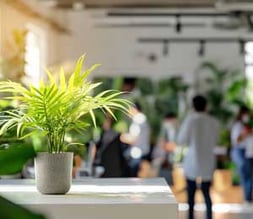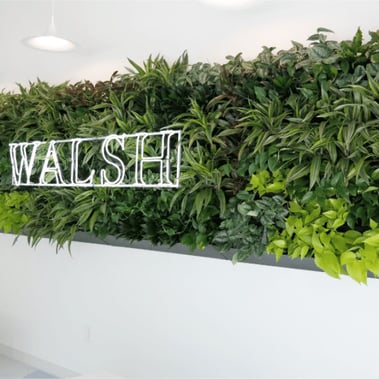[Update] Reduce Office Noise with Live Plants and Green Living Walls
Strategically placed office plants and lush, green living walls can effectively reduce disruptive office noise, contributing to a quieter and more productive environment. Here’s how…
“Sound affects us psychologically, cognitively and behaviorally, even though we’re not aware of it.”
– Julian Treasure, CEO The Sound Agency.
According to a recent global survey on the impact of office noise, 58% of employees still prefer their home environment for focused work, with 45% believing that it better supports their overall productivity. Additionally, over a quarter of the surveyed employees cited office noise and the inability to focus as reasons why they preferred to work from home.
In recent years, hot desking and open-plan office layouts have become increasingly popular, with 7 out of 10 US companies incorporating some kind of open office plan. But this has only created a noisy and distracting work environment, with various studies proving that sound impacts heavily on our productivity.
From a cognitive, psychological and behavioral standpoint, sound pollution and noisy distractions can cause employees to become distracted and disengaged for several minutes at a time, which can become a costly problem (see this Tech Report article for more on how open-plan offices impact the workforce).
 According to a recent study detailing the impact of workplace sound level on employees’ physical wellbeing, the pandemic may have shifted our perception of ideal noise levels. Contrary to popular belief, the study suggests that the quiet environment typical of home offices (around 50 decibels), is actually optimal for productivity. The study also showed that even low levels of sound (below 50 decibels) can trigger a higher stress response, highlighting the importance of quieter environments for wellbeing (read this overview for more insight into this study).
According to a recent study detailing the impact of workplace sound level on employees’ physical wellbeing, the pandemic may have shifted our perception of ideal noise levels. Contrary to popular belief, the study suggests that the quiet environment typical of home offices (around 50 decibels), is actually optimal for productivity. The study also showed that even low levels of sound (below 50 decibels) can trigger a higher stress response, highlighting the importance of quieter environments for wellbeing (read this overview for more insight into this study).
Do You Hear All That?
Shhhhh… Sit back in your chair, close your eyes, take a deep breath and exhale…
If you’re in an office, it’s likely that you’re listening to your colleagues' noisy chairs, constant phone calls, the coffee machine brewing, and unrelenting office chatter. You might have grown accustomed to these types of disruptions, but it’s been proven that environmental distractions can hinder your productivity and focus, which ultimately affects your workplace’s bottom line.
With this in mind, you should actively be investing in strategies to mitigate noise pollution and enhance workplace wellbeing, especially as a business manager or senior employee. Prioritizing a serene, biophilic-inspired workspace through biophilic design principles not only enhances employee satisfaction but also drives greater returns on investment for the organization.
But letting employees work from home full time is not always a viable solution, which is why integrating green walls and plants into office spaces can be considered a game-changer for reducing office noise and curating a quieter, more peaceful workplace.
Green Walls Reduce Noise Pollution
Noise occurs when sound waves travel and bounce off rigid surfaces like walls, ceilings, floors and other hard objects in the room, which makes an empty office environment a hotspot for noise pollution. In an office devoid of proper insulation, sound can easily be transmitted, bouncing from person to person and between furniture and rooms, which can make for a particularly noisy and distracting office space.

This is where office plants really shine as the MVP, with research proving that green walls are able to reduce noise pollution by up to 50%, thanks to their noise abatement capabilities.
In a 2014 study on how plants can effectively reduce noise in the built environment, Green Plants for Green buildings proved that green or living walls displayed similar or better acoustic absorption than other common building materials. It also found that living walls were more efficient at absorbing sound in public places where voice frequency was around 60dB, working well as passive acoustic insulation.
How Exactly Do Plants Reduce Noise?
If you want to create a quieter, more peaceful office environment, it’s important to understand how plants reduce noise. As a result of their acoustic capabilities, plants provide insulation against noise, sound vibrations, and sound penetration.
Owing to their biomass and natural density,, indoor office plants can absorb echoes and dampen reverberations that occur when sound waves reflect off of flat surfaces. As natural sound absorbers, plants effectively dampen reverberations through deflection, refraction and absorption, resulting in a calmer and quieter workplace environment.
- Deflection: Plants absorb sound energy and deflect waves in various directions, unlike rigid surfaces, likewalls, which reflect sound waves back towards the source.
- Refraction: Sound waves change direction when encountering different surfaces or materials. Plants covering surfaces are effective in sound wave refraction, dispersing sound waves and reducing echoes. Green walls are a great example of sound wave refraction as they improve acoustic quality and reduce echoes.
- Absorption: Plants reduce noise by absorbing sound through their stems, leaves, and branches. The rough bark and thick leaves of certain plants are especially effective because of their surface area. Factors affecting sound absorption include the number and size of plants, as well as the surface area of leaves and plants.
The Benefits of Plants in the Workplace
Choosing the right plants for your work space can have a positive impact on the environmental acoustics in your office. Certain plants are better able to absorb and diffuse noise, which means that choosing appropriate plants will have more of an impact when it comes to boosting the productivity and morale of your workforce. As we now know, this filters all the way down to the company’s bottom line.
Lush, green living walls (including moss walls) are especially innovative and cost-effective. They’re also a visually striking solution to solve noise pollution in your office space.
Another benefit of live plants and living walls is their ability to act as partitions between desks. Using free-standing green walls for added privacy between desks can significantly enhance productivity levels in the office. (For information on the positive impact of plants on employee wellbeing, read our piece on The Benefits of Indoor Plants.)
Considering the constant noise and distractions prevalent in a modern office environment, the significance of biophilic design - especially with regard to employee wellbeing and workplace productivity - is invaluable. Natural elements like the right indoor plants and living green walls are effective tools that help to combat noise pollution, enhance productivity, and foster a more peaceful work environment.
As businesses continue to navigate a new normal in the post-2020 workplace culture, it’s evident that green walls and indoor office plants are not just decorative, . but a pragmatic step toward quieter, more efficient working conditions.





-Apr-26-2024-01-35-50-7428-PM.jpg)
